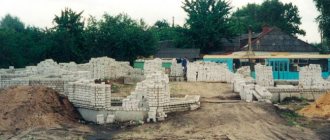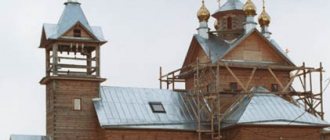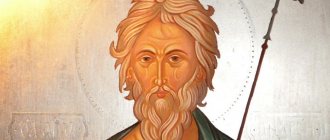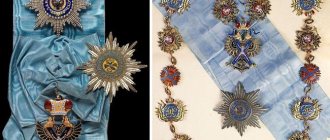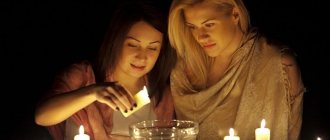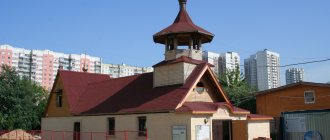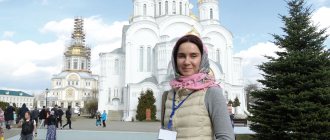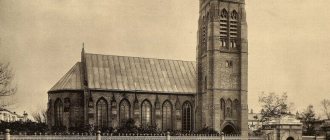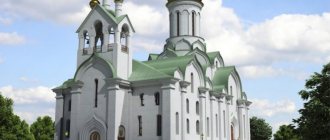The history of the Church of the Apostle Andrew began with the construction of a temple in the name of St. Tikhon.
The history of the Church of the Apostle Andrew begins on April 13, 1999, when His Holiness Patriarch Alexy II of Moscow and All Rus' was still the head of the Russian Orthodox Church (ROC).
April 13, 1999
from this day the Church of the Apostle Andrew begins its history
He arrived in Lyublino, where there was not yet a single church, and consecrated the foundation stone for the throne of the future church in the name of St. Tikhon, Patriarch of All-Russia.
The church was located on the territory of the Orthodox community of Apostle Andrew the First-Called. It was a small wooden church for 120 - 150 people.
Construction of the first church in the temple complex
The first services began in the basement (ground floor) of the temple on January 1, 2000. At this time the temple itself was being built and the parish was growing. Its consecration took place on the bright spring holiday - Annunciation (2001).
The services themselves, in the then wooden church, began on Easter 2003. The temple began to be ennobled and covered with facade stone.
Since 2006, on the territory of the temple complex there has been a children's Orthodox singing gymnasium “Lublino” (9 classes). In addition to the usual school and music education, children also receive spiritual education.
Orthodox singing gymnasium in Lyublino
With the growth of the parish, the question of building a new large cathedral became acute. The Church of the Apostle Andrew the First-Called (designed for 1,500 people) appeared to them.
The construction of the temple was announced on the patronal holiday.
In his speech to the people, Archpriest Viktor Shkaburin said:
“Today we have an unusual patronal holiday. Today we celebrate our anniversary!
Our parish is 20 years old! During this time, we created a strong Orthodox community, a spiritual family.
We organized the education of our children in the Orthodox gymnasium.
And this year we already had our first graduation, and all our students entered the colleges of their choice.
We are 20 years old!
And finally, the time has come to begin the construction of the main capital temple.
All the preparatory work, which is invisible to the eye, has practically been completed. I ask for prayers!”
Victor Shkaburin
archpriest
This is what the Church of the Holy Apostle looks like according to the project
The construction of the Church of the Apostle Andrew was included in the “200 churches” program. This program started in Moscow in 2010. The goal is the construction of Orthodox churches in that part of the city where at the moment they are especially lacking, because existing churches cannot accommodate all parishioners.
Thanks to the “200 temples” program, the Church of St. Andrew the First-Called was built. Website of the 200 temples program
The construction of the Church of the Apostle Andrew was included in the “200 churches” program. This program started in Moscow in 2010. The goal is the construction of Orthodox churches in that part of the city where at the moment they are especially lacking, because existing churches cannot accommodate all parishioners.
The peculiarity of the cathedral is that it is supposed to have only 1 dome. There will be no columns in the temple premises. This is very convenient for parishioners, because... nothing blocks the view and you get more space and better acoustics.
The belfry is adjacent to the facade of the building and they form a vast temple area in front of the main entrance to the temple. The cathedral will be beautiful, white stone, like old Russian times.
The Church of the Apostle Andrew is still under construction, so you can see such an announcement at the entrance
Upon completion of construction, it is planned to delineate the “responsibilities” of the temples.
Regular liturgies and baptisms will take place in the church in the name of St. Tikhon, Patriarch of All-Russia; holiday liturgies and educational activities will move to the new church of St. Andrew the Apostle.
The rector of the temple also talks about plans for a concert hall in the Cathedral of St. Andrew the First-Called, where students of the singing gymnasium will perform, an exhibition hall and a museum (ecclesiastical historical).
The temple is still under construction and no services are held there.
Initially, the building allocated to the gymnasium was intended for domestic needs, so it is small in size and not enough for all students. They plan to expand it with the help of a temple under construction, where the gymnasium will occupy the ground floor.
Previously, there were no churches in Moscow named in honor of St. Andrew the First-Called, although he is the first enlightener of Rus', or rather the land where the predecessors of the Slavs lived. Although in Russia the saint is highly revered (the highest order of Russia is the Order of St. Andrew the First-Called, St. Andrew's Cross is the flag of our fleet).
Church of the Holy Apostles Peter and Paul in Lyublino
“Dear Lyublino, where is the light, bright home”
| Palace in Lyublino |
According to legend, the history of Lyublino began during the time of False Dmitry I. As if the army of the impostor with the Cossacks and archers who went over to his side passed to Moscow through the future Lyublino.
And supposedly then his warriors were the first to settle and populate these still wild lands. However, reliable information about this area dates back to the end of the 16th century. Then the estate, (more precisely, a wasteland), named Yurkino after one of the owners, passed from hand to hand of different owners. It was ruined during the Time of Troubles, but already in 1622, Tsar Mikhail Fedorovich granted Yurkino to clerk Grigory Larionov. And at the end of the “rebellious” 17th century, Yurkino belonged to the steward Grigory Petrovich Godunov, one of the last representatives of this family, which emerged under Tsar Fyodor after his marriage to Irina Godunova. The new owner of Yurkin was a distant relative of Tsar Boris Godunov. Grigory Petrovich Godunov fell in love with this estate, named it by his own name - Godunovo and built an estate, and buried his children in the neighboring Nikolo-Perervinsky monastery. After the owner’s death in 1704, ownership passed to his only daughter Agrafena, who did not die in childhood, who married Prince Vladimir Nikitich Prozorovsky, adjutant to Field Marshal Prince Mikhail Golitsyn, who distinguished himself in the Northern War and the Battle of Poltava. How closely everything is connected in Moscow history: this Golitsyn was the ancestor of the owners of the neighboring Kuzminki estate.
Godunovo eventually passed to the heir, Prince Pyotr Vladimirovich Prozorovsky, under whom it became known as Lyublino. There is an original version that the new owner married a commoner, and she called the estate “Love and But” with the emphasis on the second syllable - she loved it so much. Although, perhaps, the new name was simply invented according to the then fashion for sentimental, romantic names. The estate was indeed very loved by the owners, although it was a simple village with a wooden manor. And the owner’s son, Prince Vladimir Petrovich, had already inherited the estate as Lyublino, but he became its last owner from the Prozorovsky family.
In the 1790s, Princess Anna Andreevna Urusova bought this inexpensive estate from them. But her beloved daughter Sophia, wife of Baron A.S. Stroganov, the owner of Kuzminki, by the way, also related by family ties to the Golitsyns, soon died, and the grief-stricken mother could no longer be within the walls of the Lublin estate, where everything reminded her of her daughter. According to one version, she sold it to Countess Maria Grigorievna Razumovskaya, known for her scandalous love marriage with Count Lev Kirillovich Razumovsky - he won her at cards from her disgusted husband, Prince A.N. Golitsyn, second cousin of V.P. Prozorovsky. Other scientists believe that Urusova immediately sold the estate to a retired brigadier (major general), actual state councilor Nikolai Alekseevich Durasov.
The ancestor of the Durasovs, Ivan Dmitrievich, came from Poland to serve Ivan III, and since then the Durasovs have honestly “served as nobles in various ranks,” so the new owner also belonged to an old family. And his mother Agrafena Ivanovna was the daughter of the Ural miner Myasnikov. All four of Myasnikov’s daughters – Durasov’s aunts – remained in the memory of Moscow. Daria Myasnikova, who became the wife of A.I. Pashkova, built herself an estate on Mokhovaya, which is now occupied by Moscow University. Catherine married Senator G.I. Kozitsky, who built a palace for her on Tverskaya - now the Eliseevsky grocery store, and even named the local Kozitsky Lane in honor of his beloved wife. Irina Myasnikova got married to P.A. Beketov and became the owner of Zyuzin, which once belonged to the noblewoman Morozova. Agrafena became the wife of foreman A.N. Durasov, who built a magnificent palace on Pokrovsky Boulevard, which left the name to Durasovsky Lane. Their son Nikolai acquired Lyublino on the occasion of his retirement. The estate was almost abandoned, meager, deserted, and he was free to build whatever he wanted in it, embodying all the whims of his imagination. Fabulous family wealth - 2 factories and one and a half thousand serfs, a property near Moscow near the city of Pushkin and an estate in the Simbirsk province (by the way, described by the admiring S.T. Aksakov in the book “The Childhood Years of Bagrov the Grandson”) - gave him the freedom to live the way he wanted , for which Durasov and his relatives received the nickname “evangelical rich people.”
According to legend, the vain eccentric especially dreamed of receiving the Order of St. Anne without having any awards. And he wanted to distinguish himself with such and such capital! This order was established by Empress Anna Ioannovna: it was an equal-ended cross made of dark ruby glass with a round medallion, which contained an image of St. Anna. The ends of the cross were connected by an openwork pattern. Over time, the Order of Annin was half-forgotten, and only Paul I restored it on the day of his coronation in 1797.
According to legend, the emperor was one of the first to award this order to Nikolai Durasov. And supposedly, having received the coveted reward, the “fresh gentleman” bought Lyublino and invited the architects Rodion Kazakov and Ivan Egotov, who were then working in Kuzminki, to perpetuate their dream in stone: to build a palace that symbolically captured the Order of St. Anne. The plan of the three-story house includes an equal-ended cross with a circle in the middle, and the ends of the cross are connected by a round colonnade. The internal layout echoes the general design of the combination of a cross and a circle: in the center of the first floor there is a round main hall, on the second floor there is the same hall, but smaller. Side rooms extend from the round halls on four sides, like the sides of a cross. The building was crowned by a large dome, topped with a statue of Apollo, the patron of the arts, to which the owner of the estate was very inclined. The uniqueness of the location and layout of the palace lay in the fact that all its windows offered marvelous distant panoramas: Kolomenskoye, the Nikolo-Perervinsky Monastery, the Moscow River and even the Kremlin towers with cathedral domes were visible. Durasov did not build a house church for himself. There was a monastery nearby, and most importantly, the owner did not intend to live here: according to legend, he never even spent the night here. He built a purely pleasure palace, “rich in amenities and hospitality,” where he held his luxurious feasts and balls.
Scientists believe that the legend about the order was invented by the next owners of the estate after Durasov’s death - to attract the public to Lyublino. Even the very fact of awarding Durasov this order is called into question, although they do not refute it. The real prototypes of the Lublin palace include rural houses near Rome, and the works of the Italian Andrea Palladio, and the revised project of the “temple of fine arts” of the theorist of French classicism Jean-François Nefforge, and even the project of the “Apollo salon” in Versailles, created by Nicodemus Tessin the Younger for the king. sun of Louis XIV. And especially the “Russian Versailles” - imperial Pavlovsk.
It is believed that the design of the Lublin estate belonged to Rodion Kazakov, and Egotov only embodied it. Durasov's house was a temple of art, for the architecture of classicism gravitated towards antiquity. The front “half” of the palace on the ground floor consisted of three luxurious halls, each with its own purpose. The central Round Hall served as a dining room; in the Columned or Pink Hall, named after the color of the walls, there was a living room. The third, extraordinarily beautiful Marble Hall, decorated in different shades of marble, was a romantic hall for lovers - balls were held there. These halls were painted by the famous Italian painter D. Scotti, and the bas-reliefs were made by a Russian serf master named Luca. On the third floor there is a luxurious belvedere with a round hall and windows on four cardinal directions.
Hospitable Durasov loved not only to treat, but also to surprise his many guests. He could invite a rich nobleman and a poor student sitting in the park to have a snack on the grass, assuring him that the refusal would greatly offend him. The table was always set for 30 kuverts, and one serf cook cooked for everyone, and from food produced on the master's lands: sterlet, pike perch and crayfish from Lublin ponds, asparagus from the gardens, veal from the barnyard and even their own wine like champagne from Durasovo Crimean villages! No wonder the poet Dmitriev said that “Durasov lived in Lyublino like a satrap.” The owner had a strange habit of scolding his treat. In response to the enthusiastic praise of the guests, he good-naturedly retorted: “Trash, sir, absolute rubbish!” But if he noticed that a guest liked his wine, he ordered several bottles to be placed in his carriage. There is another opinion: Durasov played tricks on the guests, assuring them that all the food was “homemade,” and the simpletons fell for this bait and spread it all over Moscow. There were other guests to match the joker-host. For example, Prince D.E. Tsitsianov, also famous for his cheerful disposition, once told at the table how valuable cloth was woven from fish wool and he personally presented it as a gift to His Serene Highness Potemkin.
In 1812, Lyublino did not suffer thanks to Durasov’s feasts. The quantity and quality of the provisions stored attracted the attention of the French generals. While uninvited guests ate crows in burned Moscow, the high command had a hearty dinner at Durasov’s house (although the owner himself was going through the war on his Simbirsk estate), as a result of which the estate was not ruined.
Next to the palace there were buildings of a theater and a drama school, where actors studied stagecraft. Durasov's fortress theater was not inferior to Sheremetev's. His troupe was led by the famous actor Pyotr Alekseevich Plavilshchikov, who performed on the stage of the Petrovsky and then the Imperial Theater in Moscow. And here Durasov did not change his habit. In 1806, he gave a holiday in Lyublino in honor of Princess E.R. herself. Dashkova. Her companion recalled that the small and active owner could be mistaken for a dwarf rather than a knight of this magical palace. The guests were entertained in the theater with plays and ballet, and the master apologized for the “utter wretchedness” of what they saw - they say, all the other people are busy doing field work.
Even in St. Petersburg they knew about the Durasov theater. In May 1818, he was personally visited by the Dowager Empress Maria Feodorovna, wife of Paul I. She was shocked by the actors, then toured the estate, selected her favorite plants in the greenhouse, awarded the gardener and dined with the owner, who gave the most solemn reception in her honor, which became the last Durasovsky holiday in Lyublino. In memory of the august visit, a bronze bust of the empress was installed in one of the halls. Already in June of the same year, Durasov died from accidental blood poisoning. “He was a kind man. The whole city regrets his death,” this is how his contemporaries responded to his death.
Temple at Golofteyeva Dacha
| Lyublino. Church of Peter and Paul. Photo from the 1900s |
Durasov was not married and had no descendants.
The house was inherited by his sister Agrafena Alekseevna, who married a distant relative, General Mikhail Durasov, thus unexpectedly preserving the family surname. With her, the fun of Lyublino ends, but its economic era begins. She also married her daughter Agrippina to the general and senator Alexander Alexandrovich Pisarev, a participant in the Patriotic War, later a trustee of the Moscow educational district and the Warsaw military governor. He owned the Bolshie Gorki estate. It was he who built that very manorial estate with outbuildings, which Shekhtel slightly rebuilt for Zinaida Morozova and where the Bolsheviks later settled the dying Lenin. Pisarev, having become the owner of Lyublino, sought to turn it into an exemplary farm. He ordered a herd of expensive Tyrolean cows (each costing 35 chervonets), set up a greenhouse for pineapples and dates, and also invited guests - among them was Ivan Mikhailovich Snegirev, the famous Moscow historian. Only now, instead of the theater, the guests were having fun with walks in the garden. The new owners usually lived in Gorki, and Lyublino was given over to dachas for wealthy townspeople. From then on, it began to turn into a dacha area.
But something didn’t work out in the Pisarevs’ family life. In 1840, the general complained to a friend in a letter that he was being kicked out of his “nest,” from “dear Lyublino.” And in 1848 he died, and the widow, unable to cope with managing the huge farm, sold the estate to the Moscow rich man N.P. Voeikov. Soon the abolition of serfdom came, and he was also unable to maintain such a property. So Lyublino fell into the hands of the merchant of the 1st guild Konon Nikonovich Golofteev and his companion Pyotr Rakhmanin.
Together they were engaged in the trade of “fashionable ladies' goods.” In addition, Golofteev owned an arcade on Petrovka, which he built on the site of the very first arcade in Moscow - the gallery of Prince M.A. Golitsyn, erected in 1835. The Golitsyn gallery soon passed to Golofteev and began to be called Golofteevskaya. Let us mention that its building burned down at the beginning of the twentieth century, and in 1912 the architect I. Rerberg built a new Golofteyevsky passage on that site - the last passage of pre-revolutionary Moscow and the first store built of reinforced concrete. It was dismantled after the war and a new building of the Central Department Store was built in that place.
The partners jointly owned Lyublino. They owned a palace in which they vacationed with their families in the summer, for which they slightly altered it, leaving the layout and interiors untouched. They gave the Lublin lands exclusively for dachas and sought to attract wealthy audiences with all sorts of originalities.
Meanwhile, on May 30, 1872, the Polytechnic Exhibition opened in Moscow, organized in honor of the 200th anniversary of the birth of Peter the Great. Just three years ago, the Ethnographic Exhibition, organized by the Society of Lovers of Natural History, Anthropology and Ethnography at Moscow University, was held with great success. And then the idea came to hold an exhibition of applied natural science (the future Polytechnic), which would present all the useful technical inventions and innovations in a variety of fields - from gardening to medicine, as well as their use in the everyday life of poor people. Thus, a department of rural home economics was created, where, among other things, an interesting wooden church was exhibited, which can be assembled on your own, without an architect, without losing its beauty. To reduce costs, the committee did not hold a competition, but asked one of its members, the architect of the palace department Nikolai Aleksandrovich Shokhin, to develop a project for such a church. He was noted for the successful restoration of the Great Kremlin, Nikolaevsky and Poteshny palaces, the Palace of Facets, the Trinity Tower and the legendary Church of the Ascension in Kolomenskoye, and then became one of the architects of the Polytechnic Museum and donated his precious library to it.
The Polytechnic Exhibition occupied the entire Alexander Garden, Manezh, and the Kremlin Embankment. The church was designed by Shokhin in the form of a collapsible log frame, covered with a tent, and decorated with kokoshniks. It was demonstrated in the Alexander Garden near the Borovitskaya Tower as the main exhibit and an example of Russian style. The church could accommodate 200 people, and at the same time it could be easily dismantled, moved to another place and reassembled there again without much effort. If Shokhin knew that by doing this he saved the life of his creation! It was found to be extremely elegant in architecture, and was praised for its simplicity and character, befitting an Orthodox Russian rural church with choirs and belfry.
It is noteworthy that both the iconostasis and the utensils were made in the Russian style. Moreover, the decoration was from the best domestic companies: the brocade and vestments were supplied by the Sapozhnikovs, the silver by the Khlebnikovs, and the icons were painted by Palekh masters.
This extraordinary, original beauty, combined with practicality, amazed the companions. They purchased it for Lyublino right at the exhibition, by the way, along with “exemplary” wooden houses for dachas, also made in the Russian style, which was in harmony with the temple.
The church went to Lyublino after the exhibition closed in September 1872, and the rest of its exhibits became part of the newly created Polytechnic Museum, where a model of this church was presented. For her project, architect Shokhin was awarded a gold medal.
The acquired church was placed east of the “master’s house” and consecrated in the name of Saints Peter and Paul, after Rachmanin’s name day. The patronal feast fell at the height of the dacha season, and the church did not have its own clergy, being assigned to the Blachernae Church in Kuzminki: the priest served on summer holidays for summer residents, and in winter the church was closed. Soon Rachmanin died, and Golofteev became the sole master of Lyublino. From now on, his house was called “Golofteev’s dacha.”
In the summer of 1866, Dostoevsky rented a dacha in Lyublino. At that time, the writer was working on the novel Crime and Punishment. The first chapters had already been sent to the publishing house, and they needed to finish the novel as soon as possible. Dostoevsky was unwell, lonely and did not have a quiet place to work until he went to Lyublino to visit his sister Vera, who rented a dacha here. He liked this quiet corner so much that he immediately hired himself a shelter “through an acquaintance” for half the price and, to celebrate, even invited his unloved stepson to live at his dacha. The writer occupied only one room on the second floor of the former noble boarding house, set up by Durasov. His relatives hired him a footman, afraid to leave the sick writer alone, but soon he flatly refused to help Dostoevsky, telling him that the master was planning to kill someone: he walked around the room all night long and talked about it out loud. The writer fell in love with long walks around the area, and described his impressions of this summer in the story “The Eternal Husband.”
At the end of the 19th century, the famous philologist F.I. lived at a dacha in Lublin. Buslaev. He was almost blind and dictated his memories here, and in July 1897 he died in Lyublino.
After the construction of the Moscow-Kursk railway, Lyublino became one of the best and most expensive holiday destinations, so that a whole holiday village called Novy appeared next to the estate. But the stinginess of the owners - Lyublino had already passed to Golofteev’s son Nikolai Kononovich - became the reason for the decline of the Lublin “dacha season”. Here every piece of land was valued, houses were placed close to each other and even in such “bare” areas that were not suitable for summer holidays. In addition, at the end of the 19th century, urban “irrigation fields” were built in the neighborhood, which pushed many away from the “Lublin paradise.” And in June 1904, a terrible hurricane destroyed many houses, a grove and a pond with crucian carp. The newspapers claimed that Golofteev was offered one hundred thousand rubles for the trees felled in the park alone. And the light but strong church stood, although the trees nearby were uprooted. The roof of the manor house was torn off and the statue of Apollo was damaged. Golofteev ordered another sculpture in Hamburg - a copy of the “Herculanean Woman”, which was kept in the Dresden Museum, only it was made not from marble, but from a more resistant alloy of spiatra, similar to lead. So the “Herculanian” replaced Apollo, but everyone took her for a statue of St. Anne.
Return to Lublin paradise
| The relocated Church of Peter and Paul, now the Vvedenskaya Church in Ryzhevo, Egoryevsky district, Moscow region |
After the revolution, the palace was mercilessly exploited by various non-core institutions: first it housed a school, then a railway workers’ club named after the Third International, then workshops and warehouses.
Sad changes did not escape the Lublin church either. After the decree on the separation of the Church and the state, all church property was nationalized, and believers were required to draw up an agreement with the authorities on the further operation of the temple building. So in 1918, an independent and permanent parish of the Peter and Paul Church was created from local residents, henceforth separated from the Blachernae Church in Kuzminki. Since 1919, priest Alexander Remov, who studied at the Moscow Theological Academy, became its rector, and Vladimir Fedorov, a former hierodeacon of the Chudov Monastery, became its deacon. The confiscation of church valuables did not spare this temple either: in April 1922, all silver utensils were removed from it. Of course, they were approaching the church from all sides. The next year, 1923, “at the request of the workers and artisans of the Moscow-Kursk Railway” and “by resolution of the RCP and RKSM cells on the liquidation of the temple,” the Lublin City Council decided to transfer it to the Komsomol club, although such a club already existed in the Durasov palace, and the church was under the protection of the Museum Department. Nevertheless, this decision was approved by the Presidium of the Moscow City Council. In March 1924, the temple was sealed, and the venerable architect N.A. came to inspect it. Vsevolozhsky, who at one time worked in the Commission for the Protection of Architectural Historical and Artistic Monuments and collaborated with A.V. Shchusev, and then designed the famous Kashira power plant. The condition of the temple was assessed as deplorable: the roof was leaking, the walls were peeling, the windows were broken. But from the outside the temple remained very picturesque. Experts called his style “Ropetovsky” (from the pseudonym of the artist I.N. Petrov, who was one of the first to create buildings, illustrations and even advertising labels in the Russian style) and noted that this is almost his only example.
The parishioners defended their temple as best they could and asked to have the seals removed by Easter. After that, for a short time he acted according to the decision of the local authorities, but the All-Russian Central Executive Committee stopped such arbitrariness and confirmed the decision of the Moscow Council to completely close the temple, without finding “grounds” for its revision. The interiors of the temple were destroyed and a “godless corner” was opened in the altar. And then a miracle happened.
In 1923, in the village of Ryzhevo, Yegoryevsky district, Moscow province, his Vvedensky Church, built long before the revolution at the expense of the merchant of the 1st guild Semyon Maikov, burned down for the second time. They say that the villagers found a wealthy benefactor, a Nepman, who agreed... to buy them a new temple. And the Peter and Paul Church could not have been better suited for safe movement. In 1927, the authorities allowed it to be transferred to the village of Ryzhevo, and the Presidium of the Moscow Soviet specifically demanded that the previous dimensions and forms of architecture be preserved. It was successfully moved, reassembled and, maintaining the dedication of the burnt church, reconsecrated in honor of the Entry of the Most Holy Theotokos into the Temple. So it stands to this day, seven miles from Yegoryevsk and is still in operation. But they could have taken it apart for firewood.
And the Moscow palace N.A. Durasov was occupied by the Institute of Oceanology of the USSR Academy of Sciences in 1948 and was vacated only in our recent times, when it was no longer possible to operate the building, which, by the way, was under state protection. The historical monument was in a disfigured state, but retained its layout and bits of the original interior. That is why it was possible to carry out a scientific restoration of this architectural pearl, which regained its original “Duras” appearance. They made various plans for the further operation of the palace, in particular, they wanted to place a bank in it, but by the decision of the mayor it was left as a museum. Interestingly, it was thanks to this palace that a new Moscow metro station, Volzhskaya, appeared, which was not planned. The Lyublino station was supposed to open nearby, but its construction in a protected historical zone was rejected, and this station was moved a kilometer away, and instead of it, an additional Volzhskaya station was built in the distance.
The restored palace has become the pride of the Lyublino district, although museum staff complain that even local residents know practically nothing about it, not to mention other Muscovites. But this is the most original example of Moscow classicism, a genuine historical monument (not a remake!), and all this revived splendor can now be seen with your own eyes.
In the future, it is planned to recreate the Peter and Paul Church according to the drawings of the architect Shokhin. After all, the historical church of Lyublino did not perish.
Materials from the article were partially used: Ivanov Yu.V., Maznitsyna O.A. The history of one exhibit (Temple in Lyublino) // Moscow: Events, people, problems. Local historian Sat. M., 1997.
Schedule of services in the temple complex
The schedule of services is posted on the official website of the temple.
Temple complex of St. Andrew the First-Called Apostle Official website
The schedule is updated monthly. In addition to the Liturgy, conversations are held in the church.
- Conversation with the rector;
On Saturdays, at the end of the evening service (at about 19.00), the rector of the church, Father Victor, answers questions from parishioners.
- Gospel Conversations;
On Thursdays after the evening service at 7:30 p.m., Priest John Koval gives talks about Faith and the life of the Church.
- Conversations about holy ascetics;
On Fridays, at the end of the evening service (at about 18.30), conversations are held about the history of the Church, the life of the Holy Ascetics of Piety. Conducted by Alexander Evgenievich Chermensky
- Public conversations.
In our church, public conversations are held for adults and children over 12 years of age who consciously wish to be baptized, as well as for parents of baptized children and those who want to become godparents.
Conversations are held in the church every Saturday at 15:00. Without public conversations, the sacrament of baptism cannot be performed (except in the event of a fatal illness of the person wishing to be baptized).
